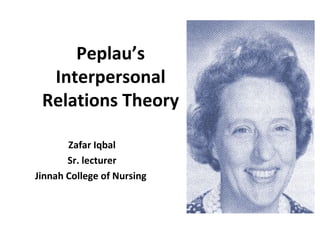
Peplau’s+interpersonal+relations+theory+power+point
- 1. Peplau’s Interpersonal Relations Theory Zafar Iqbal Sr. lecturer Jinnah College of Nursing
- 2. Hildegard E. Peplau’s Interpersonal Relations in Nursing Regarded as “mother of psychiatric nursing” Born in 1909 , Pennsylvania Diploma from Pottstown Hospital School of Nursing, BA in interpersonal psychology from Bennington College Pennsylvania in 1931. MA in psychiatric nursing from Colombia University, New York in 1947 Her Theory was published in 1953 Framework for psychodynamic nursing
- 3. Continue… Theory was influenced by Harry Stack Sullivan’s theory of interpersonal relations. Middle range, descriptive, classification theory she led the way towards humane treatment of patients with behavior and personality disorders. Nurses, she thought, could facilitate this through observation, description, formulation, interpretation, validation, and intervention. she taught interpersonal concepts and interviewing techniques, as well as individual, family, and group therapy.
- 4. Interpersonal Relations in Nursing Theory • Stresses the importance of nurses’ ability to understand their own behaviors to help others identify perceived difficulties. • Emphasizes the focus on the interpersonal processes and therapeutic relationship that develops between the nurse and client. • Four phases of the nurse-patient relationship are identified
- 5. 4 Phases of nurse-patient relationship • Orientation-client seeking assistance, meeting of nurse-patient, identifying the problem and services needed ( interview process), and guidance. • Get familiar phase of the nurse-patient relationship. • Parameters are established and met • Early levels of trust are developed • Roles begin to be understood
- 6. Phases cont. Identification- identifying who is best to support needs, patient addresses personal feelings about the experience and is encouraged to participate in care to promote personal acceptance and satisfaction. • The client begins to identify problems to be worked on within relationship • The goal of the nurse: help the patient to recognize his/her own interdependent/participation role and promote responsibility for self
- 7. Phases cont. Exploitation- patient attempts to explore, understand and deal with the problem, and gains independence on achieving the goal • Client’s trust of nurse reached full potential • Client making full use of nursing services • Solving immediate problems • Identifying and orienting self to [discharge] goals
- 8. Phases cont. Resolution- termination of the therapeutic relationship to encourage emotional balance for nurse and patient ( difficult for both patient and nurse as psychological dependence persists) • Client met needs • Mutual termination of relationship • Sense of security is formed • Patient is less reliant on nurse • Increased self reliance to deal with own problems.
- 9. Peplau's Seven Nursing Roles • Peplau's Seven Nursing Roles illustrate the dynamic character roles typical to clinical nursing. • Stranger role: Receives the client the same way one meets a stranger in other life situations; provides an accepting climate that builds trust. • Resource role: Answers questions, interprets clinical treatment data, gives information. • Teaching role: Gives instructions and provides training; involves analysis and synthesis of the learner's experience.
- 10. Peplau's Seven Nursing Roles • Counseling role: Helps client understand and integrate the meaning of current life circumstances; provides guidance and encouragement to make changes. • Surrogate role: Helps client clarify domains of dependence, interdependence, and independence and acts on clients behalf as advocate. • Active leadership: Helps client assume maximum responsibility for meeting treatment goals in a mutually satisfying way. • Technical expert role: Provides physical care by displaying clinical skills; Operates equipment
- 11. Application of Interpersonal Theory in Nursing Practice • An article in Current Nursing evaluated using the theory in nursing practice – Assessment= Orientation phase – Nursing diagnosis – Planning=Identification phase – Implementing=Exploitation phase – Evaluation=Resolution phase (the theory allowed client’s needs to be assessed. Application of the theory helped provide comprehensive care to the client)
- 12. Research completed • Urology Nursing used the theory to educate newly diagnosed bladder cancer patients with the need for a urinary diversion, and ensure understanding. Outcome shows that the scope of a patient’s needs requires a competent nurse to assume the changing roles in the four phases of the theory, expressing the importance of involving the patient in establishing goals and reviewing the goals frequently.
- 13. Research completed • British Journal of Nursing had an article researching the credibility of Peplau’s theory, in mental health care, due to the expansion of nursing knowledge and the dynamics of a multidisciplinary team currently used in today’s practice. • Public Health Nursing did a study, in homecare visits, (testing the use of Peplau’s theory) to work with multi- problem families, to identify interventions, individualized for the members, to see if relationship progression was increased within the family system resulting in optimized care of the patient.
- 14. Application of theory in “MY” nursing practice • This theory would be useful with our newly diagnosed cancer patients and their family. Resistance is met when trying to educate them about the treatment, encouraging enrolment in studies, and education about how to care for the patient in their home setting. – Orientation-patient gets admitted to the unit, nurse helps the patient to recognize and understand that they have cancer and the importance of treatment. – Identification-Patient takes the time to internalize the diagnosis, the nurse participates in helping the patient to do so. -- Exploitation-the nurse works to have the patient explore what help is needed to meet goals, incorporating other disciplines to problem solve (oncologists, therapists, alternative medicine, etc.).Patient test the limits of the nurses availability, and the nurse encourages patient to evaluate ways to meet their final goals. -- Resolution-when in-patient treatment is complete, the nurse has to evaluate feelings and remove themselves from the bond that is made, allowing the patient and family to move on and regain balance in their own lives.